Common Submerged and Floating Plant Information
|
Aquatic -herbaceous floating or submerged |
|---|
|
Fern |
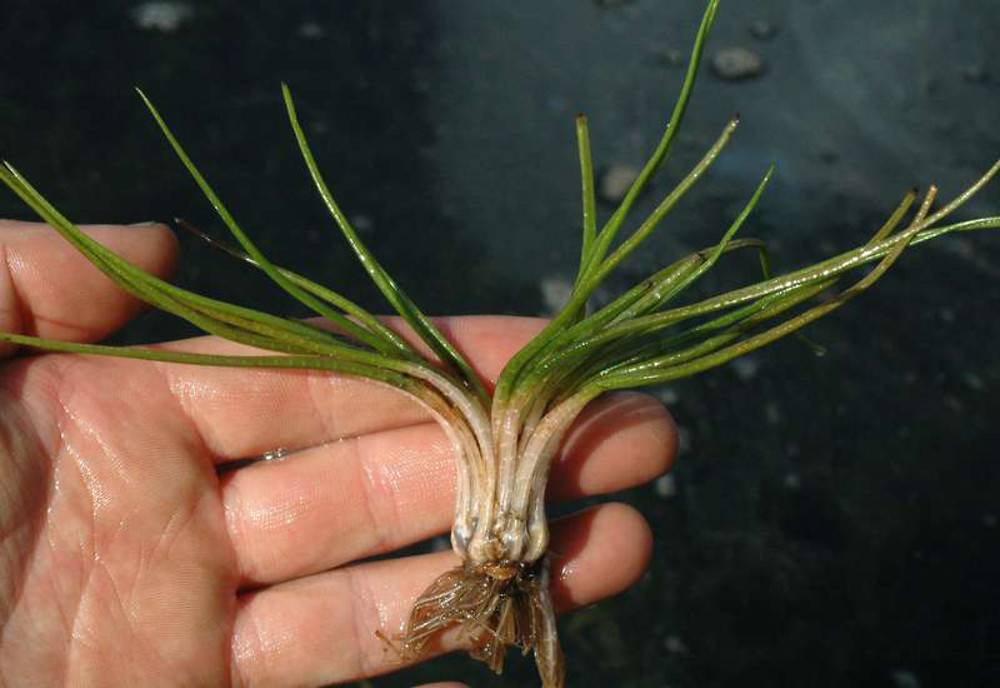
Isoetes sp. – quillwort
Isoet-aceae
Submerged fern (actually lycophyte); leaves all basal (forming a rosette), simple, linear, and entire. Outermost and innermost leaves typically sterile pointed with spoon-like base; outermost leaves have ֎sporangia bearing megaspores (inside spoon-like base of leaf), inner leaves have microspores; stem is modified into a corm (underground onion like structure); shallow to moderate depths in lakes and slowly-flowing rivers on sandy substrates, mud, and wet ground. Quillworts are an interesting example of convergent evolution due to their use of CAM photosynthesis.
|
Aquatic -herbaceous floating or submerged |
|---|
|
Dicot |
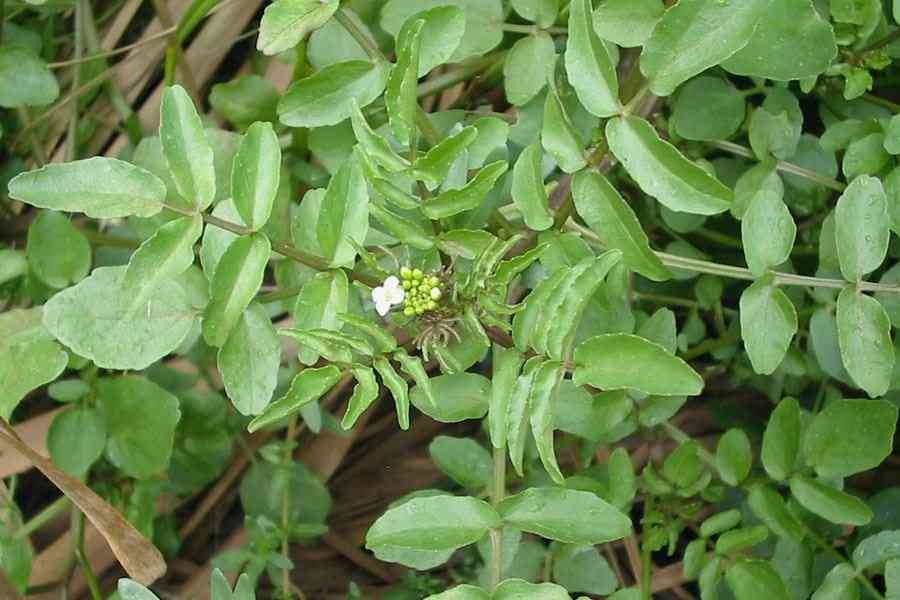
Rorippa nasturtium-officinale – water-cress (new name Nasturtium-officinale)
Brassic-aceae
Aquatic herb; spreading stems either floating or submerged, smooth and anchor to the bottom at many points, typically the stem sticks out of the water; leaves ֎pinnately compound divided into 3-9 segments, with leaves 4-12 cm long by 2-5 cm wide with a terminal lobe that is often larger than the rest; leaf margins complete or with a few small teeth, with petioles; flowers approx. 5 mm wide, white, 4 petals cross-like (distinct for family), in one to several recemes per stem; fruit a curved to linear pod tipped with beak containing coarsely textured seeds; May-September; springs and slow-moving steams; prefers water less than 65 degrees F. Sometimes found in the grocery store produce section, if you collect wild individuals make sure to only collect the emergent portions because the “pond scum” that quickly accumulates below water can be highly toxic.
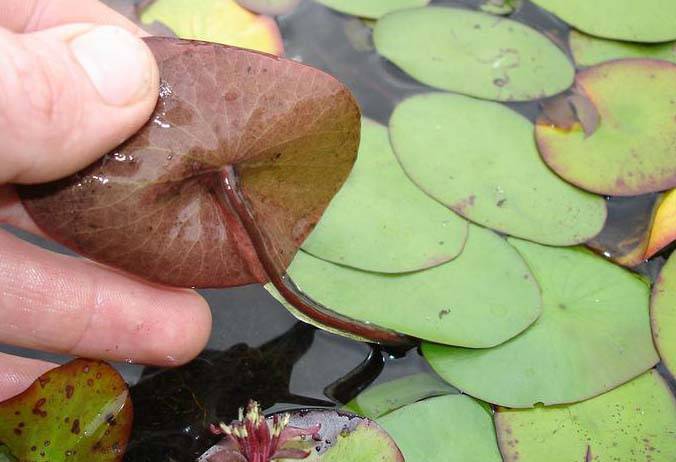
Brasenia (schreberi) – water-shield, snot weed
Cabomb-aceae
Floating herb, underwater component of plants have slippery ֎jelly-like coating (snot-like) which is more pronounced on young shoots; leaves ovular, floating, 4-12 cm long and as half wide green above and purple below, ֎peltate (petiole attaches centrally underside, shield-like); stems up to 2m long and smooth; flowers maroon to purple <3cm wide, sepals 3 and petals 3 12-15mm long; fruit small and oblong 3-5 mm; July; soft water lakes and ponds with high decomposed organic matter, sometimes acidic. The jelly-like coating is an excellent medium to throw at siblings during a water fight.
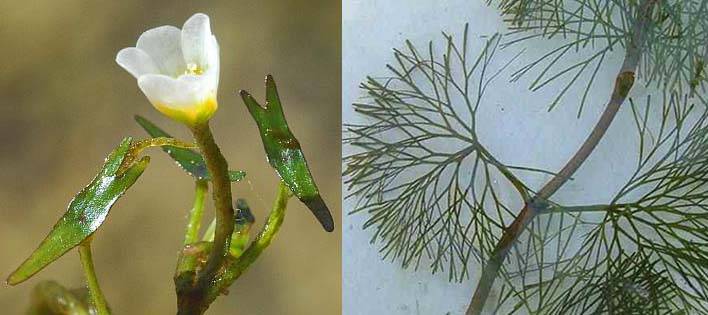
Cabomba (caroliniana) – fanwort
Cabomb-aceae
Submerged herb; leaves highly dissected ֎opposite ֎ sometimes with floating leaves dimorphic (ovalish with a leathery texture). Commonly sold for fish tanks.
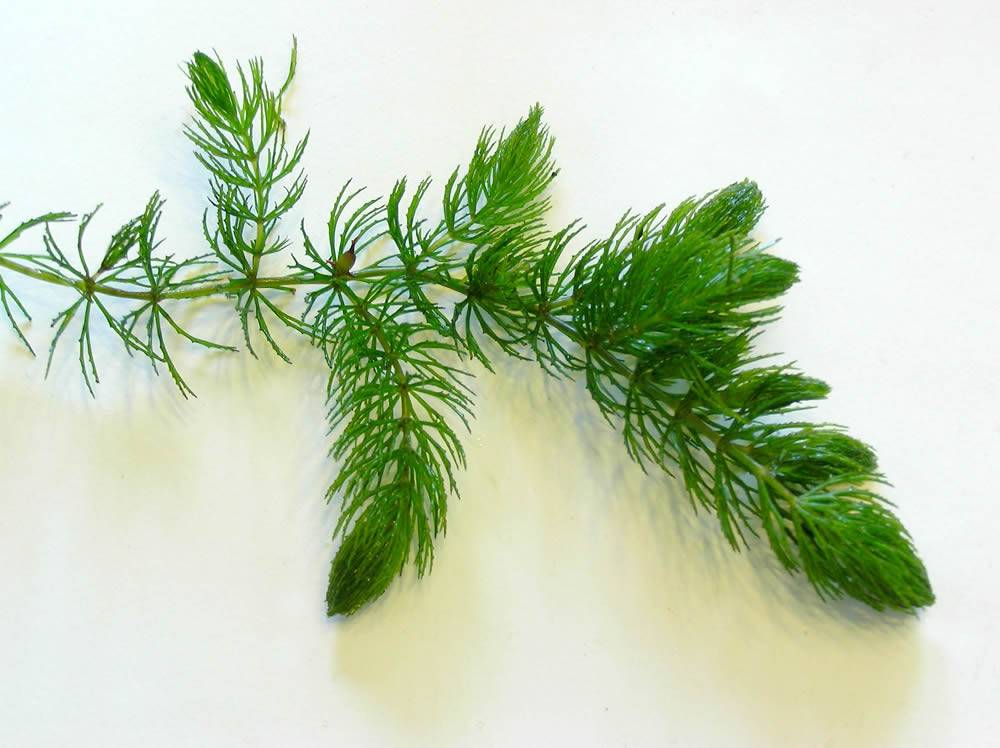
Ceratophyllum sp. – coontail
Ceratophyll-aceae
Exclusively submerged; leaves ֎whorled, ֎dichotomously forked with ֎spiny teeth along one side, more crowded toward the tip giving the “coontail” appearance; plants free floating, without roots; variable in length; ponds, shallow marshes. Weird fact: vascular plant with no vascular tissue.
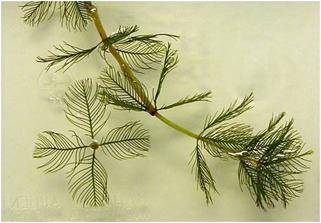
Myriophyllum sp. – water milfoil
Haloragid-aceae
Submerged herb (some species can grow out of the water); stems simple or branched, ֎submerged or sometimes floating or ascending; leaves variously arranged, usually ֎whorled and pinnately compound ֎ (feather like in appearance); inflorescence terminal or axillary; mostly submerged or seasonally terrestrial. There are several species in the region although most water ways are dominated by the invasive European milfoil (Myriophyllum spicatum); generally identification is difficult and sometimes impossible without genetic analysis due to hybrids, but if you find the emerged inflorescence, then this guide can help with identification.
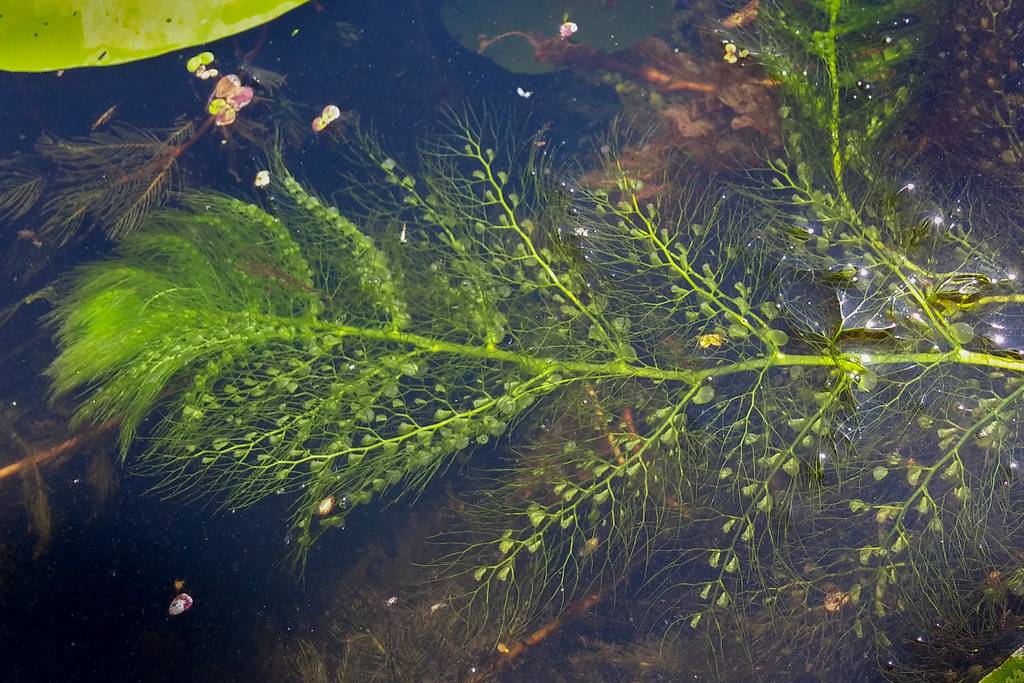
Utricularia sp. – bladderwort
Lentibulari-aceae
Aquatic herb usually submerged and floating near the surface; leaves filament-like, branched submerged in mud or floating horizontally in shallow water usually with ֎tiny bladders (to catch small animal life); flowering stalk several inches tall, flower zygomorphic with two lips and a spur, mostly yellow; fruit a pod; shallow marshes, muddy shore. There are many species in West Michigan associated with very low nutrients (hence carnivorous), but Utricularia vulgaris is commonly found in nutrient rich waters.
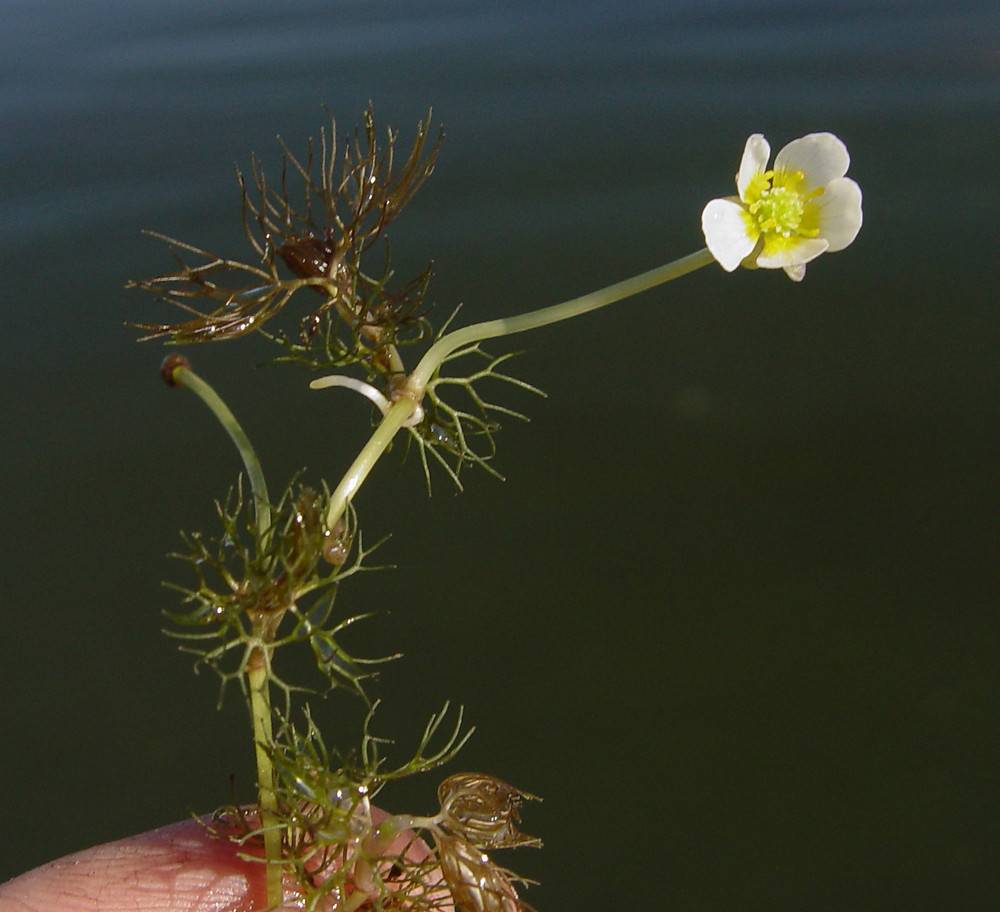
Ranunculus sp. – buttercup
Ranuncul-aceae
Common herb; the genus can have simple to compound leaves but are ֎generally very deeply lobed forming three distinct lobes; flowers with ֎5 green sepals and 5 yellow to white petals and many pistils. Aquatic species leaves dissected similar to Myriophyllum-Utricularia with ֎3 distinct lobes (crow foot) and ֎alternate.
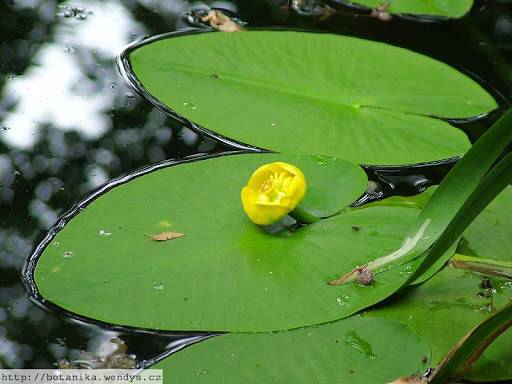
Nuphar sp. - yellow water lily
Nymphae-aceae
Floating or emergent herb; large floating leaves, ֎leaf blades oblong to oval or heart-shaped; underground stem (rhizome) thick and fleshy (֎sometimes firm petiole, may have emergent leaves); floating flower, with ֎rounded yellow petal-like sepals.
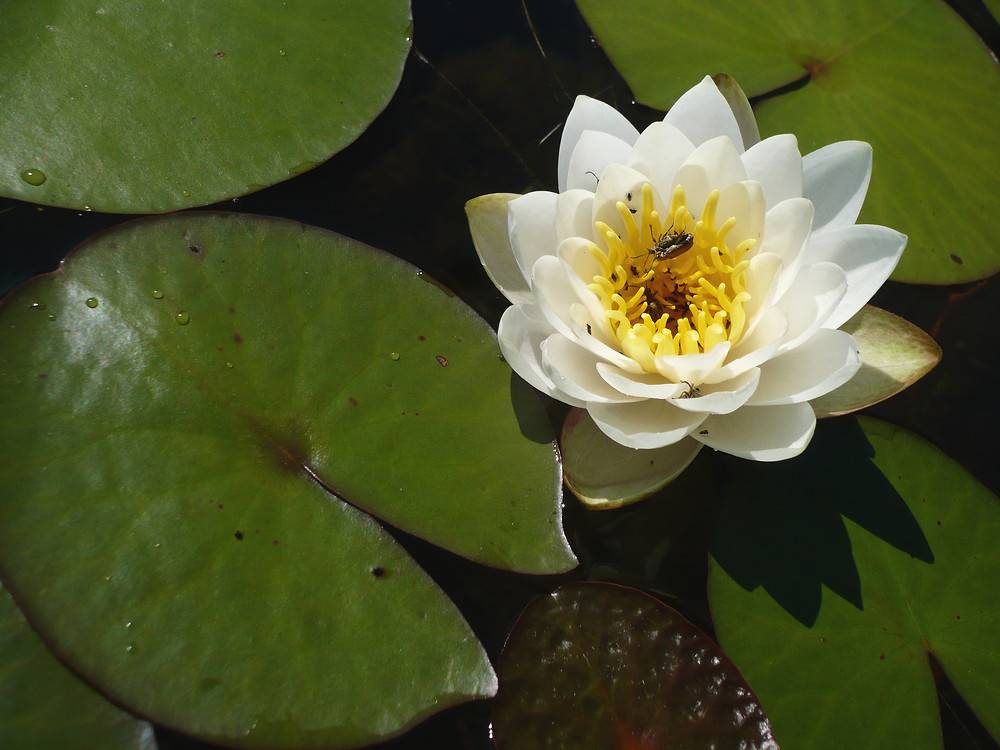
Nymphaea odorata - fragrant water lily
Nymphae-aceae (֎large floating leaves ֎massive rhizome ֎many stamen)
Floating herb; large floating leaves, ֎nearly round in shape with a ֎v-shaped cleft (vampire teeth); underground stem (rhizome) thick and fleshy (֎weak stem, leaf floats directly on water surface); floating flower is white, fragrant with ֎numerous petals and stamens; marshes and ponds, 10-55cm deep.
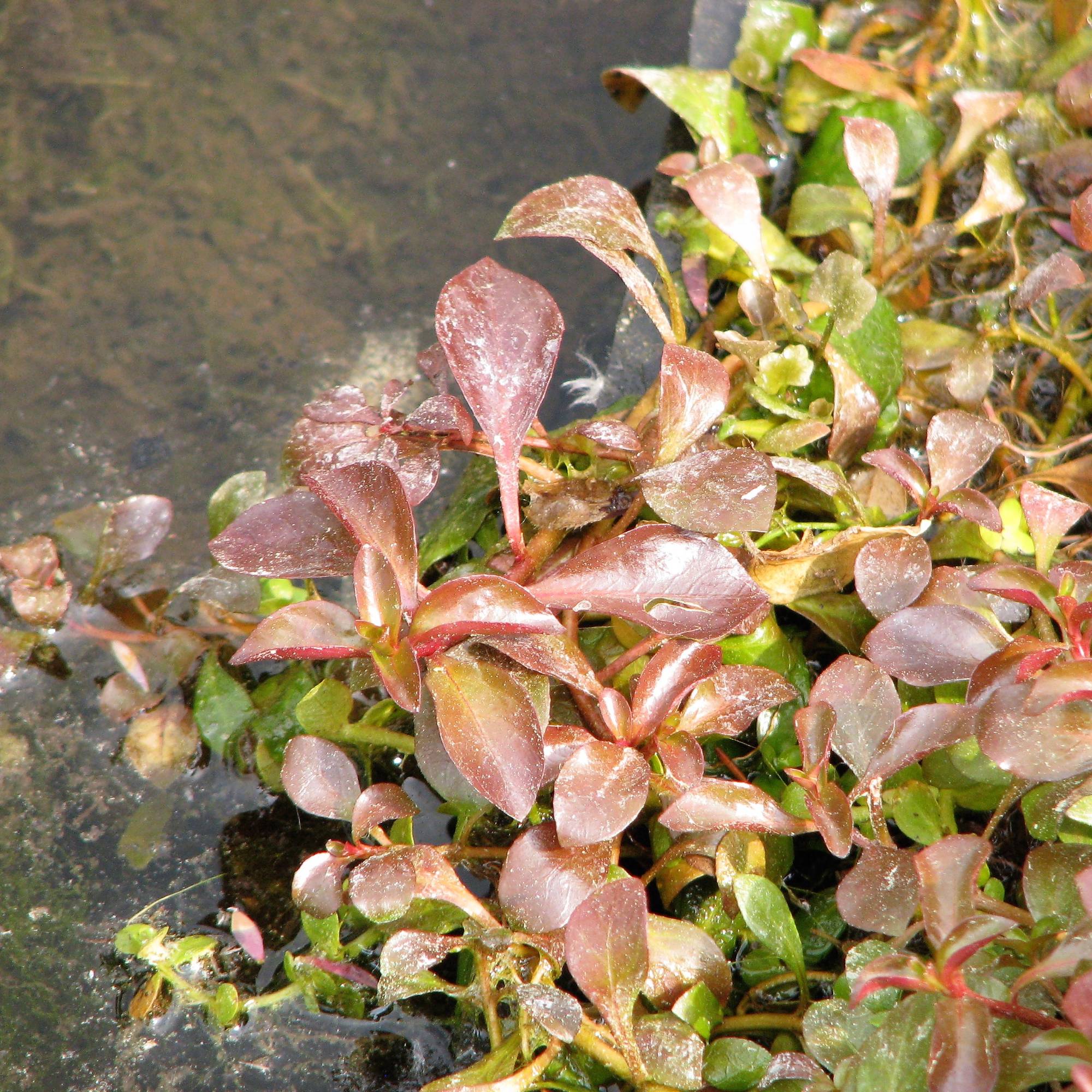
Ludwigia palustris - water-purslane
Onagr-aceae
Aquatic herb preferring wet soils but can live indefinitely underwater; ֎leaves opposite, ovate to lance-shaped, green to red in color, best recognized by a ֎red bottom (only prominent with high light intensity), tapered at base to ֎winged petiole; stems poor, creeping or partially floating, branched to simple, smooth or with sparse scattered hairs; flowers stalkless and single from leaf axils, petals absent and sepals triangular; fruit a capsule; July-September; shallow water or exposed mud on pond margins.
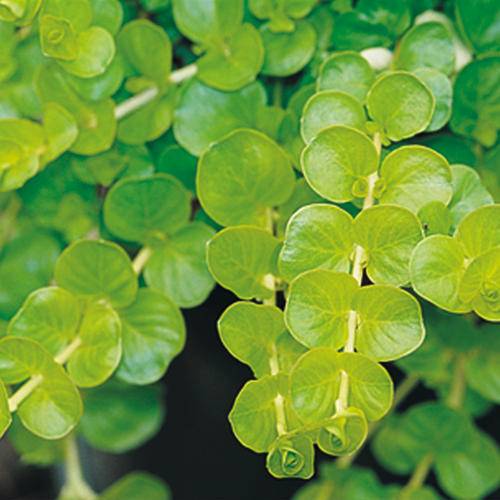
Lysimachia nummularia - moneywort, creeping jennie
Primul-aceae
Small herb in wet soils that can tolerate being submerged indefinitely; leaves ֎opposite, ֎dotted with black glands, ֎round to oval usually in mats; creeping stems low to ground (used as ground cover in landscaping); flowers single in leaf axils with triangular petals; usually shady, wet areas; June-August.
|
Aquatic -herbaceous floating or submerged |
|---|
|
Monocot |
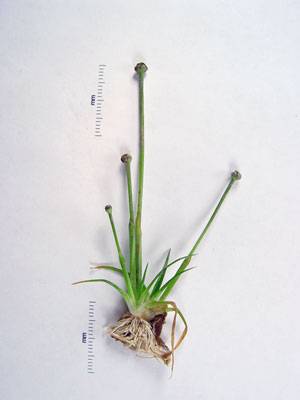
Eriocaulon (aquaticum) – pipewort
Eriocaul-aceae
Aquatic herb (generally fully submerged) with spongy ֎distinctly segmented unbranched roots; leaves grass-like in a rosette, thin and translucent with parallel veins and 3-9 conspicuous cross-veins; stems single, leafless slightly twisted and stick out of the water (up to 3m long); flowers minute with hairy tepals, either male or female on same or separate plant in a round head at the terminal end of the stem; fruit is a small 2-3 seeded capsule; July-September; sandy or peatland shorelines, shallow water, acidic lakes.

Lemna minor – duckweed
Lemn-aceae
Floating herb; with roots; ֎one root to each joint/frond; ֎green underneath; 2-5mm long; joints rounded, not stalked; float until cold weather; shallow marshes, ponds, stagnant waters.
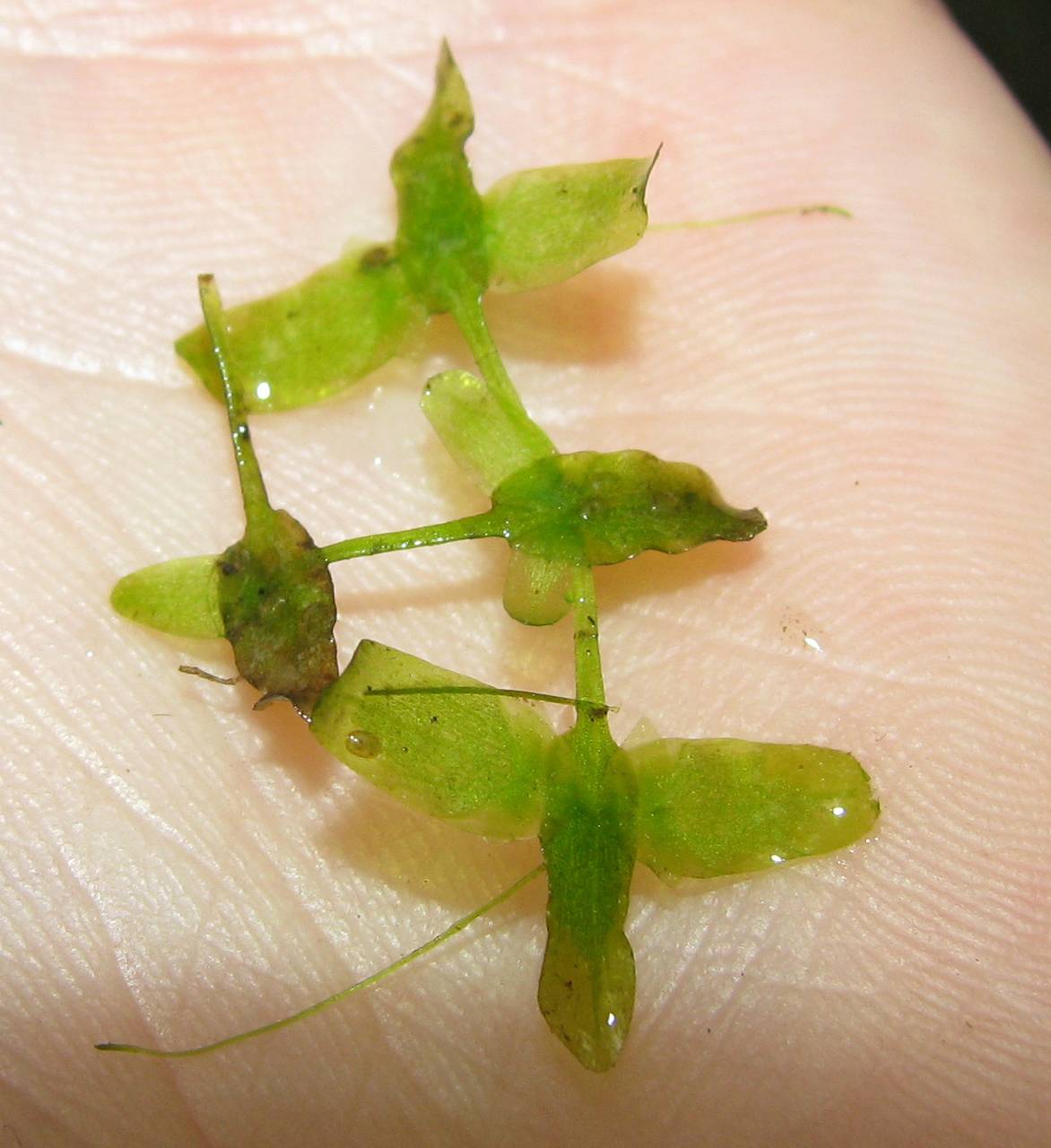
Lemna trisulca – star duckweed
Lemn-aceae
֎Floating beneath the surface; with roots; one root to each joint/frond; green underneath; joints of plants ֎long and narrow (triangular), ֎stalked (making a distinctive pattern); commonly sinking; shallow marshes, ponds, stagnant waters.
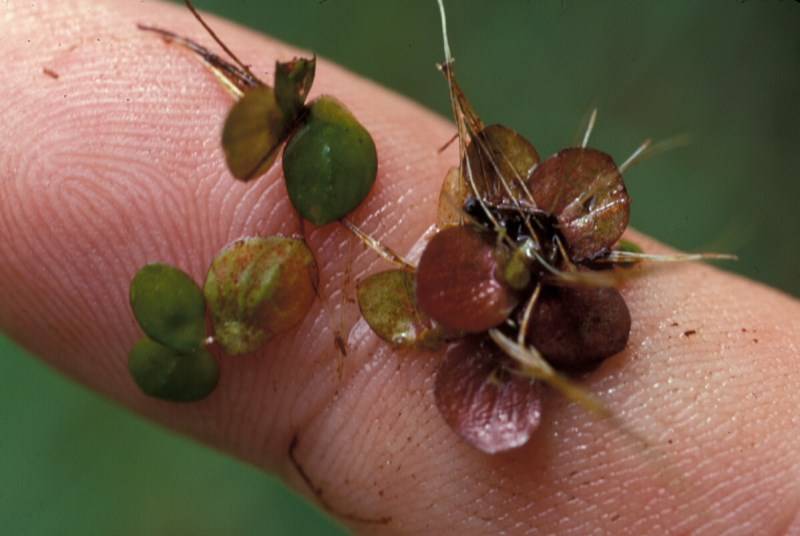
Spirodela polyrhiza – big duckweed
Lemn-aceae
Floating herb; with roots; ֎red on the lower surface; ֎each joint/frond with several roots; relatively large (3-10mm); shallow marshes, ponds, stagnant waters.
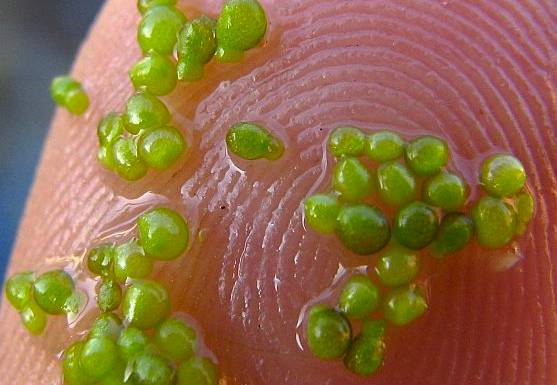
Wolffia sp. – water meal
Lemn-aceae
Floating herb; ֎without roots; plants globular, tiny: size of corn meal grains, 0.5-1.5mm long (֎smallest flowering plant known to science); shallow marshes, ponds, stagnant waters.
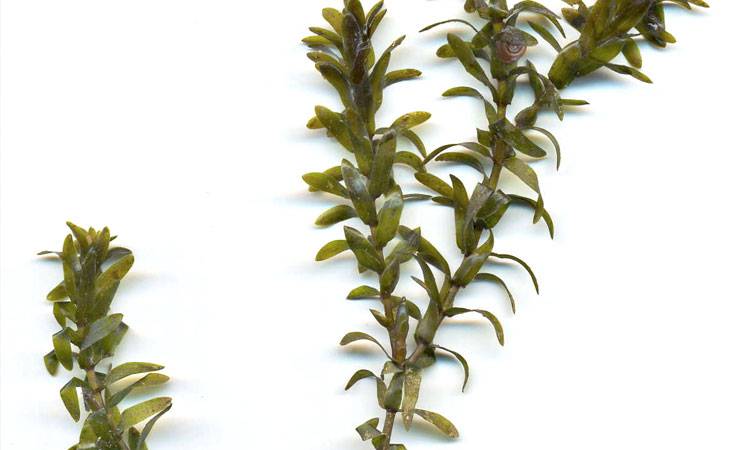
Elodea sp. – waterweed
Hydrocharit-aceae
Submerged herb; branching stems forming large masses at the bottom; ֎leaves in whorls of 3, ֎small ribbon-like; flowers from a spathe, pistillate with a long thread-like tube reaching surface; shores, ponds, shallow marshes.
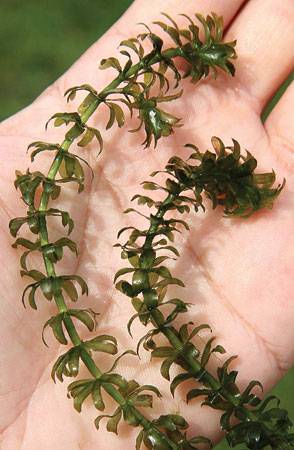
Hydrilla (verticillate) – waterthyme
Hydrocharit-aceae
Invasive submerged herb on the watch list for Michigan, if you find it then report it; leaves ֎small ribbon-like similar to Elodea but ֎leaves in whorls of 5, ֎leaf margin finely serrate.
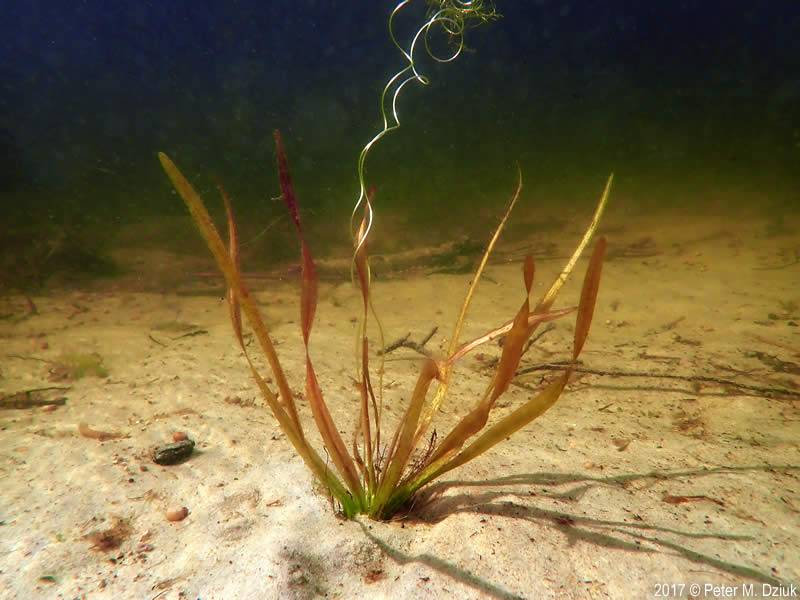
Vallisneria americana – wild celery, tape grass
Hydrocharit-aceae
Submerged herb; all leaves basal (forming a rosette), spreading by rhizomes which may be short and give a clumped appearance; ֎leaves long and strap-like with ֎3 distinctive layers and horizontal veins (crack-like in appearance); fruit with long corkscrew or ֎spring-like stalk. Plants male or female; female produce flowers which float at surface and attached to long peduncles, male plants produce flowers which are released under water and rise to surface to float freely; ponds, shallow marshes.
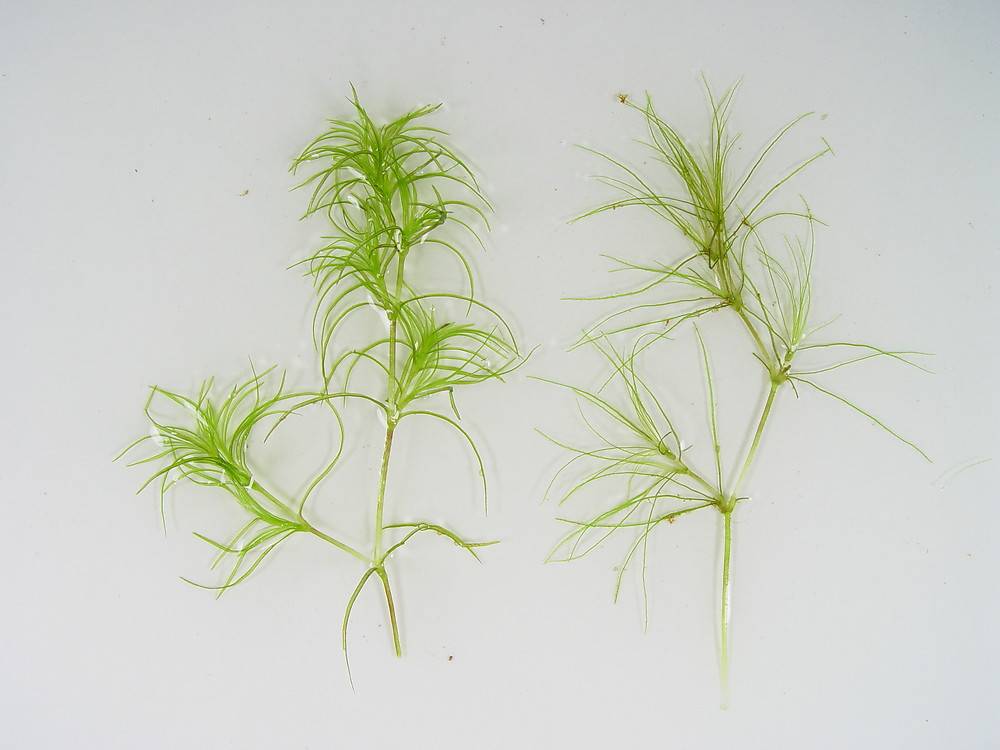
Najas sp. - naiad, water-nymph
Najad-aceae (moved to Hydrocharit-aceae)
Submerged herb (most species are annuals), fibrous roots, emerge from slender stalk; most species thin leaved (almost thread-like); however a few species have robust leaves; ֎leaves opposite, paired, with ֎tiny teeth (spinulose), simple, or in crowded whorls stalkless, ֎widened leaf at base of stem, tapering to tip; ֎typically with a branch arising from each leaf, size and spacing of leaves is highly variable; stems fine and wavy; flowers develop in leaf axils, single, stalkless, male and female flowers separate and may be on different plants; male flowers have a paper-thin envelope surrounding; fruit is a 1-seeded achene, with a glossy surface and 30-50 rows of small pits; July-September; shallow to deep waters, marshes and lakes.
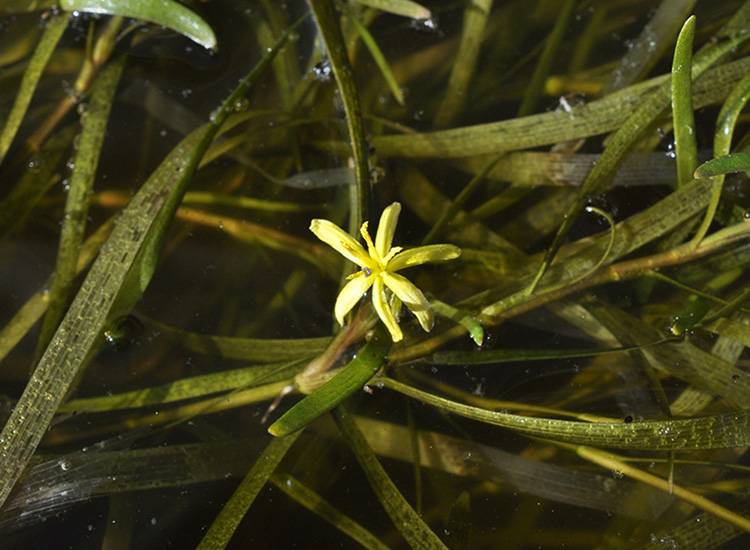
Zosterella dubia - water star-grass (also known as Heteranthera dubia)
Pontedari-aceae
Submerged herb; stems slender, elongate and freely branched; leaves alternate, sessile, linear, obtuse to rounded or apiculate at the tip, 2-10(15) cm long, 2-5(7) mm wide; ֎leaves have stipules, but unlike potamogetons, ֎lacking mid-vein; flowers single and from leaf axils; streams, lakes, ponds.
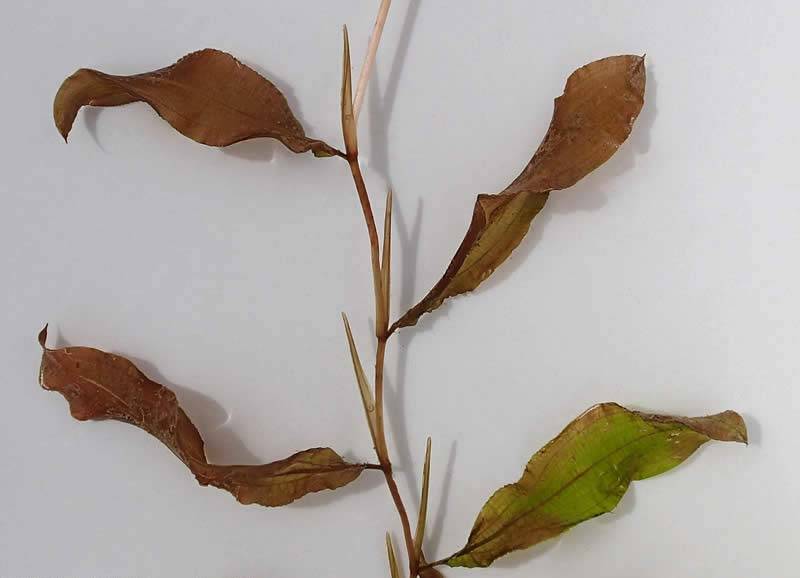
Potamogeton sp. - pondweed
Potamogeton-aceae
Submerged herb; leaves generally with pronounced ֎stipules (sometimes disintegrating), and a ֎strong mid-vein, often in two kinds ֎(firm floating or thin/membranous submersed); flowers borne in spikes ascending above the water surface for wind pollination, flowers in numerous pencil-like spikes, conspicuous in early to mid summer, retreating beneath the surface when the fruit matures. Identification is difficult; typically having more than one plant key helps tremendously and often fruit are necessary for confident identification; this supplemental key can be helpful.

Potamogeton crispus - curly pondweed
Potamogeton-aceae
Invasive submerged herb; ֎stems compressed (flat) with few branches; leaves all submersed, ֎sessile, oblong rounded at tip wavy with ֎fine toothed margins and 3-5 veins; stipule often disintegrating; shallow to deep water of lakes, highly pollution tolerant.
For other plants see the follow:
A Vegetative Key to the Genera of Submersed and Floating Aquatic Vascular Plants of Michigan
Once you know the genus you can usually narrow down the species.
